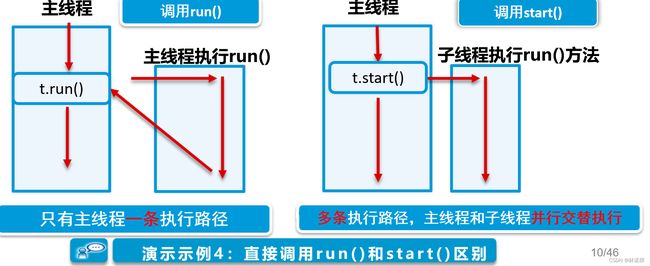Java-多线程
多线程
什么是多线程
- 如果一个进程中同时运行了多个线程,用来完成不同的工作,则称之为"多线程"
- 多个线程交替占用CPU资源,而非真正的并行执行
线程
多线程的好处
- 充分利用CPU的资源
- 简化编程模型
- 带来良好的用户体验
主线程
Thread类
- Java提供了java.lang.Thread类支持多线程编程
主线程
- main()方法即为主线程入口
- 产生其他子线程的线程
- 必须最后完成执行,因为它执行各种关闭动作
public static void main(String args[]){
Thread t=Thread.currentThread();
System.out.println("当前线程是"+t.getName());
t.setName("MyJavaThread");
System.out.println("当前线程名是:"+t.getName());
}
线程的创建和启动
- 在Java中创建线程的两种方式
- 继承java.lang.Thread类
- 实现java.lang.Runnable接口
- 使用线程的步骤
-
- 定义线程
-
- 创建线程对象
-
- 启动线程
-
- 终止线程
-
继承Thread类创建线程2-1
- 定义MyThread类继承Thread类
- 重写run()方法.编写线程执行体
- 创建线程对象,调用start()方法启动线程
public class MyThread extends Thread{
//重写run()方法
public void run(){
for(int i=1;i<100;i++){
System.out.println(Thread.currentThread().getName()+":"+i)
}
}
}
public static void main(String[] args){
MyThread thread=new MyThread();
thread.start();//启动线程
}
继承Thread类创建线程2-2
- 多个线程交替执行,不是真正的"并行"
- 线程每次执行时长由分配的CPU时间片长度决定
MyThread t1=new MyThread();
MyThread t2=new MyThread();
t1.start();
t2.start();
启动线程是否可以直接调用run()方法?
实现Runnable接口创建线程
- 定义MyRunnable类实现Runnable接口
- 实现run()方法,编写线程执行体
- 创建线程对象,调用start()方法启动线程
//实现Runnable接口
public class MyRunnable implements Runnable{
public void run(){
for(int i=1;i<100;i++){
//run()方法中编写线程执行的代码
System.out.println(Thread.currentThread().getName()+":"+i);
}
}
}
//创建线程对象
public static void main(String[] args){
MyRunnable myRunnable=new MyRunnable();
Thread myThread=new Thread(myRunnable);
thread.start();//启动线程
}
比较两种创建线程的方式
- 继承Thread类
- 编写简单
- 适用于单继承
- 实现Runnable接口
- 避免单继承局限性
- 便于资源共享
推荐使用实现Runnable接口方式创建线程
示例
public class MyThread extends Thread {
//自定义线程的第一种方式 继承Thread类
public void run() {
//可以写线程要做的事
for (int i = 0; i < 100; i++) {
if (i == 5) {
MyRunnable myRunnable = new MyRunnable();
Thread thread = new Thread(myRunnable);
thread.start();
Thread.yield();//礼让
// try {
// thread.join();
//
// } catch (InterruptedException e) {
// e.printStackTrace();
// }
// try {
// //使当前线程进入休眠状态 单位是毫秒
// Thread.sleep(1000);
// } catch (InterruptedException e) {
// e.printStackTrace();
// }
// }
if (i==20){
Thread t=currentThread();
t.interrupt();//中断当前线程
}
System.out.println(getName() + ": " + i);
}
}
}
}
public class Test02 {
public static void main(String[] args) {
// MyThread myThread=new MyThread();
// myThread.run();//放弃使用的
Thread thread=new MyThread();
Thread thread1=new MyThread();
thread.setName("a");
thread1.setName("b");
//设置优先级设置优先级1-10 默认是5 数字越大优先级越高
thread.setPriority(1);
thread1.setPriority(10);
thread.start();//保留的
thread1.start();
}
}
public class Test03 {
public static void main(String[] args) {
Thread thread=new MyThread();
Thread thread1=new MyThread();
thread1.start();
try {
thread1.join();
} catch (InterruptedException e) {
e.printStackTrace();
}
thread.start();
}
}
public class MyRunnable implements Runnable{
//创建线程的第二种方式
@Override
public void run() {
for(int i=0;i<100;i++){
//获取当前线程对象
Thread thread=Thread.currentThread();
System.out.println( thread.getName()+": "+i);
}
}
}
public class MyRunnableTest {
public static void main(String[] args) {
//通过实现Runnable接口的方式创建线程
//1.创建接口对象
MyRunnable myRunnable=new MyRunnable();
//2.创建线程对象
Thread thread=new Thread(myRunnable);
//3.调用该线程对象的start方法
thread.start();
}
}
中断线程interrupt 判断 isInterrupted
public void run(){
Thread t=Thread.currentThread();//获取当前线程
for (int i = 0; i < 20; i++) {
System.out.println(i);
if (i==5){
t.interrupt();//中断线程 修改线程状态
}
if (t.isInterrupted()){// t.isInterrupted();//获取当前状态是否被中断
break;
}
}
}
锁 synchronized
public class TicketRunnable implements Runnable{
private int ticket=10;//总票数
private static int num=0;//表示买了多少张票
private boolean flag=false;
private static Object object=new Object();
@Override
public void run() {
while (!flag){
sale();
}
}
/**
* 卖票
*/
public synchronized void sale(){
//synchronized (this){
if (ticket>0){
ticket--;
num++;
System.out.println(Thread.currentThread().getName()+":抢到第"+num+"张票"+",剩余"+ticket+"张票");
try {
Thread.sleep(200);
} catch (InterruptedException e) {
e.printStackTrace();
}
}else{
flag=true;
}
//}
//1.可以修饰代码块 也可以修饰方法
//2.修饰代码块时 需要传一个对象 这个对象可以是任意对象 一般是Object或者this
}
}
锁 ReentrantLock
import java.util.concurrent.locks.ReentrantLock;
public class TicketRunnable implements Runnable{
private int ticket=10;//总票数
private static int num=0;//表示买了多少张票
private boolean flag=false;
private static Object object=new Object();
private ReentrantLock reentrantLock=new ReentrantLock();//创建锁对象
@Override
public void run() {
while (!flag){
sale();
}
}
/**
* 卖票
*/
public void sale(){
//synchronized (this){
reentrantLock.lock();//上锁
if (ticket>0){
ticket--;
num++;
System.out.println(Thread.currentThread().getName()+":抢到第"+num+"张票"+",剩余"+ticket+"张票");
try {
Thread.sleep(200);
} catch (InterruptedException e) {
e.printStackTrace();
}
}else{
flag=true;
}
reentrantLock.unlock();//开锁
//}
//1.可以修饰代码块 也可以修饰方法
//2.修饰代码块时 需要传一个对象 这个对象可以是任意对象 一般是Object或者this
}
}
锁 synchronized 与 Lock 的区别
-
lock是个接口synchronized是一个关键字
-
synchronized锁住的方法里发生异常的时候 会释放锁 而lock不行必须手动释放
-
synchronized可以修饰方法
Lock实现提供比使用synchronized方法和语句可以获得更广泛的锁定操作
Lock中提供了获得锁和释放锁的方法
void lock():获得锁
void unlock():释放锁
Lock是接口不能直接实例化,这里采用它的实现类ReentrantLock来实例化
ReentrantLock的构造方法
ReentrantLock():创建一个ReentrantLock的实例
返回值 创建线程对象 通过实现 callable 实现
import java.util.concurrent.Callable;
//创建线程对象 通过实现 callable 实现
public class Mycallable implements Callable<String> {
@Override
public String call() throws Exception {
return "今天中午吃什么";
}
}
public class Test {
public static void main(String[] args) {
//1.创建callable对象
Callable callable=new Mycallable();
//2.创建FutureTask
FutureTask futureTask=new FutureTask(callable);
Thread thread=new Thread(futureTask);
thread.start();//启动线程
//3.获取返回值
//futureTask.isDone(); 判断线程是否结束 结束为true 不结束为false 运行时是false
while (!futureTask.isDone()){
try {
System.out.println(futureTask.get());//表示获取线程的返回值
} catch (InterruptedException e) {
e.printStackTrace();
} catch (ExecutionException e) {
e.printStackTrace();
}
}
}
}
ExecutorService 创建一个有十条线程的线程池 ThreadPool
public class Test {
public static void main(String[] args) {
//创建一个有十条线程的线程池
ExecutorService es= Executors.newFixedThreadPool(10);
Mycallable mycallable=new Mycallable();
//Future f = es.submit(mycallable);
Future f = es.submit(mycallable);
while (!f.isDone()){
try {
System.out.println(f.get());
} catch (InterruptedException e) {
e.printStackTrace();
} catch (ExecutionException e) {
e.printStackTrace();
}
}
es.shutdown();
}
}
public class MyRunnable implements Runnable{
//四种创建线程方式
//sleep join
//锁
//wait notify
@Override
public void run() {
System.out.println("线程执行");
}
}
线程池
线程池是一种用于优化线程管理的技术,它可以在应用程序启动时预先创建一组线程并保存在内存中,以避免频繁地创建和销毁线程。线程池通过限制和管理资源,降低了线程创建和销毁造成的消耗,同时提高了系统的响应速度和稳定性。在Java中,线程池通常使用java.util.concurrent包中的Executor框架来实现。
线程池的优势有以下几点:
- 降低资源消耗:通过重复利用已创建的线程,避免线程创建和销毁的开销。
- 提高响应速度:当任务到达时,任务不需要等待线程创建,立即执行。
- 提高线程的可管理性:线程是稀缺资源,如果无限制的创建,不仅会消耗系统资源,还会降低系统的稳定性。线程池可以进行统一的分配、调优和监控。
Java的Executor框架是线程池的一种实现方式,它提供了线程工厂、队列以及拒绝策略等,让并发编程变得更加简单。在Java中,常见的线程池有:
- FixedThreadPool:固定数量的线程池,当线程到达最大数量后,任务会被放入队列中等待。适用于后台或长时间运行的任务。
- CachedThreadPool:可缓存线程池,线程数量未达到最大值时,会立即执行任务。当任务过多导致线程不够用时,会创建新线程,但超过一定时间未被使用的线程会被销毁。适用于执行大量短期异步任务。
- ScheduledThreadPool:计划线程池,可以定时执行任务或周期性执行任务。适用于需要定时执行或周期性执行的任务。
使用线程池的好处在于可以更好地控制并发任务的执行,同时避免了大量线程的创建和销毁,提高了系统的性能和稳定性。在实际应用中,需要根据具体场景选择合适的线程池和参数配置,以达到最佳的性能效果。
wait notify
常见方法
| 方法名称 | 说明 |
|---|---|
| void wait() | 当前线程等待,直到被其他线程唤醒 |
| void notify() | 随机唤醒单个线程 |
| void notifyAll() | 唤醒所有线程 |
